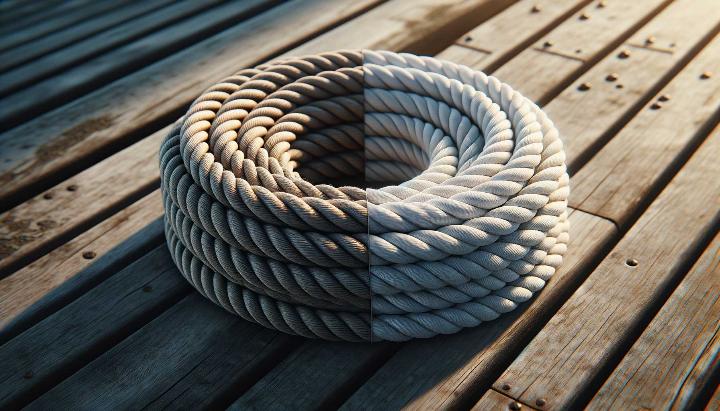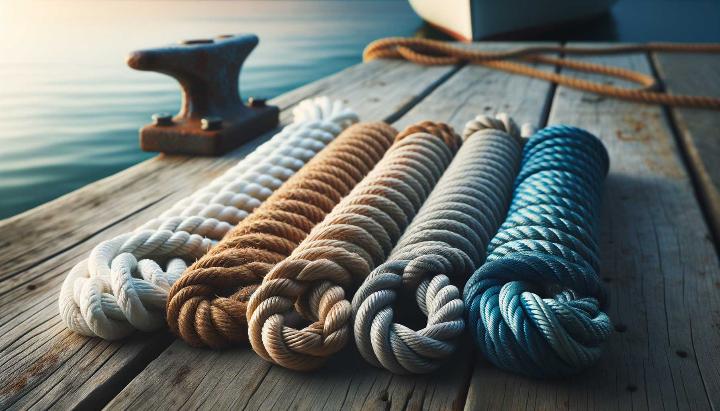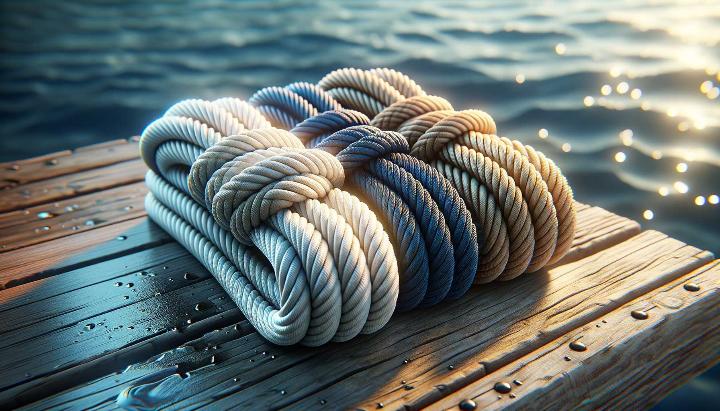Have you ever wondered why some boats stay securely moored while others drift away at the slightest breeze? The secret lies in the rope. When it comes to mooring and anchoring, three strand polyester rope has become the unsung hero of the maritime world. But why choose polyester over traditional nylon? And what makes the three-strand construction so special?
At iRopes, we've spent years perfecting the art of rope manufacturing, and we're here to unravel the mysteries of three strand polyester rope. Whether you're a seasoned sailor or a weekend boating enthusiast, understanding the nuances of mooring and anchoring ropes can make all the difference between a relaxing day on the water and a nautical nightmare.
In this post, we'll dive deep into the world of three strand polyester rope, comparing it to three strand rope braid and three strand twisted rope. We'll explore why this versatile rope has become the go-to choice for discerning boaters worldwide, and how it can revolutionise your mooring and anchoring experience. So, grab a cuppa and join us as we explore the strength, durability, and unmatched performance of three strand polyester rope - your boat's new best friend.
Understanding Three Strand Polyester Rope
When it comes to mooring and anchoring, choosing the right rope can make all the difference. Three strand polyester rope has become a popular choice among boaters and marine professionals alike. Let's dive into what makes this rope so special and why it might be the perfect fit for your nautical needs.
Characteristics and Advantages of Three Strand Polyester Rope
Three strand polyester rope is a marvel of modern marine engineering. As I run my fingers along its smooth surface, I'm reminded of the countless times it's saved the day out on the water. Here's why it stands out:
- Low stretch properties: Unlike nylon, polyester holds its shape under load, ensuring your vessel stays put in choppy waters.
- High strength-to-weight ratio: This rope punches above its weight class, offering impressive strength without unnecessary bulk.
- UV and abrasion resistance: Sun and salt are no match for polyester's durability, making it ideal for long-term outdoor use.
- Excellent performance in wet conditions: Polyester maintains its strength when wet, a crucial factor in marine environments.
Have you ever wondered why your old nylon rope seemed to stretch out over time? That's where polyester shines. Its low stretch properties mean it maintains its length and strength, even after years of use.

Applications and Uses for Three Strand Polyester Rope
The versatility of three strand polyester rope never ceases to amaze me. From small dinghies to large yachts, it's found its place in various marine applications:
- Mooring: Its low stretch properties make it ideal for keeping your boat securely tied to the dock.
- Anchoring: The rope's strength and durability ensure your anchor stays put, even in challenging conditions.
- Towing: Whether you're helping a stranded boat or pulling water toys, this rope can handle the strain.
But it's not just for boats. I've seen three strand polyester rope used in industrial settings and even in creative DIY projects. Its versatility is truly impressive.
As we explore the world of three strand polyester rope, remember that choosing the right rope is about understanding your specific needs. In the next section, we'll compare this rope to other types, helping you make an informed decision for your mooring and anchoring requirements.
Comparing Three Strand Polyester Rope and Braided Rope
As we dive deeper into the world of marine ropes, it's crucial to understand the differences between three strand polyester rope and braided rope. Having spent countless hours on the water, I've come to appreciate the unique qualities of each type. Let's explore how these two rope constructions stack up against each other.
Characteristics of Three Strand Polyester Rope
Three strand polyester rope has been a staple in the marine industry for decades, and for good reason. Its construction is simple yet effective:
- Traditional twist: Three strands of polyester fibers are twisted together, creating a rope that's easy to handle and splice.
- Cost-effective: The straightforward manufacturing process makes it more affordable than braided alternatives.
- Excellent grip: The textured surface provides better hold on cleats and winches, which I've found particularly useful during rough weather.
However, it's not without its limitations. Three strand rope can unravel if not properly maintained, and it has a slightly lower strength-to-weight ratio compared to braided rope. If you are interested in exploring braided options, check out the Unrivaled Polyester Marine Rope Solutions by iRopes.
Benefits of Braided Rope Construction
Braided rope, on the other hand, offers a different set of advantages:
- Increased strength: The intricate weaving of fibers results in a higher strength-to-weight ratio.
- Superior flexibility: Braided construction allows for easier handling and storage, especially in tight spaces.
- Abrasion resistance: The smooth surface of braided rope stands up better to wear and tear.
I remember switching to a braided polyester rope for my main halyard and being impressed by how much easier it was to work with in the mast.

When it comes to mooring and anchoring, both rope types have their place. Three strand polyester rope is often preferred for its ease of splicing and traditional look. It's also more forgiving when running through fairleads and chocks. Braided rope, however, excels in situations where maximum strength and minimal stretch are paramount.
Have you ever wondered why some sailors swear by three strand rope while others won't use anything but braided? It often comes down to personal preference and specific needs. For example, I use three strand polyester rope for my dock lines because it's easier to adjust and replace, but I opt for braided rope in high-load applications like sheet lines.
Ultimately, the choice between three strand polyester rope and braided rope depends on your specific requirements. Consider factors like your boat's size, the intended use of the rope, and your local sailing conditions. Whichever you choose, remember that proper maintenance is key to ensuring your rope performs at its best for years to come.
Three Strand Polyester Rope vs. Three Strand Twisted Rope: A Comprehensive Comparison
As a seasoned sailor, I've had my fair share of experiences with various types of ropes. Today, we're going to dive into the world of three strand polyester rope and three strand twisted rope, comparing their strengths and weaknesses to help you make the best choice for your mooring and anchoring needs.
Construction and Materials: Understanding the Basics
When I first started sailing, I was amazed by the variety of ropes available. Let's break down the construction of these two popular types:
- Three strand polyester rope: Composed of three strands of polyester fibres twisted together, creating a strong and durable rope with excellent UV resistance.
- Three strand twisted rope: Typically made from natural fibres like manila or synthetic materials like nylon, with three strands twisted together in a helical pattern.
The key difference lies in the material used. Polyester offers superior strength and durability compared to nylon, especially in marine environments. I remember the first time I switched from a nylon to a polyester rope - the difference in performance was night and day.
For those considering three strand twisted options, you might find the insights on 3 Strand Hemp Rope vs Cotton Hemp Rope Guide useful.

Strength, Durability, and Performance Characteristics
Now, let's talk about what really matters when you're out on the water - performance. Here's a quick comparison:
- Strength-to-weight ratio: Three strand polyester rope generally offers a higher strength-to-weight ratio, meaning you can use a thinner rope for the same load.
- Stretch properties: Polyester has lower stretch, which is crucial for maintaining tension in mooring lines. Twisted rope, especially if made of nylon, tends to have more give.
- UV and abrasion resistance: Polyester excels here, maintaining its strength even after prolonged sun exposure. I've had polyester ropes last for years in harsh conditions.
- Water absorption: Polyester absorbs less water, maintaining its strength when wet. Twisted ropes, particularly natural fibre ones, can weaken when saturated.
In my experience, the lower stretch of polyester rope has been a game-changer for mooring. It keeps your boat more stable, even in choppy conditions.
Applications and Best Uses for Each Rope Type
So, when should you choose one over the other? Let's break it down:
- Three strand polyester rope: Ideal for mooring lines, anchor rodes, and any application where low stretch and high UV resistance are crucial. I use it extensively on my own boat.
- Three strand twisted rope: Better suited for applications where some stretch is beneficial, such as dock lines for smaller boats or in areas with significant tidal changes.
Remember, the right choice depends on your specific needs. Consider factors like your boat's size, local weather conditions, and the intended use of the rope.
Pro tip: For critical mooring and anchoring applications, always err on the side of caution and choose a rope with a higher breaking strength than you think you'll need. It's better to be over-prepared than under-equipped when it comes to marine safety.
In conclusion, while both three strand polyester and twisted ropes have their place in the marine world, polyester often comes out on top for mooring and anchoring due to its superior strength, durability, and performance in wet conditions. As always, proper maintenance and regular inspections are key to ensuring your ropes serve you well, regardless of the type you choose.
Selecting the Right Three Strand Polyester Rope for Your Needs
When it comes to mooring and anchoring, choosing the perfect three strand polyester rope can make all the difference between a secure vessel and a potential disaster. As someone who's spent countless hours on the water, I've learned that selecting the right rope is an art form in itself. Let's dive into the key factors you need to consider to ensure your boat stays put, even in the choppiest of waters.
Understanding Three Strand Polyester Rope Properties
Before we get into the nitty-gritty of selection, it's crucial to understand what makes three strand polyester rope stand out:
- Superior strength-to-weight ratio: This means you can use a thinner rope without compromising on strength, reducing weight and storage space on your boat.
- Excellent UV resistance: As someone who's had to replace sun-damaged ropes far too often, I can't stress enough how important this is for long-term outdoor use.
- Low stretch properties: This keeps your boat securely in place, even when the waves pick up.
- Water resistance: Unlike natural fibers, polyester maintains its strength when wet, a crucial factor in marine environments.
These properties make three strand polyester rope ideal for mooring and anchoring applications, outperforming many other materials in marine settings. For more insights, consider the Unlock Top Performance with Low Stretch Polyester Rope.
Determining the Required Rope Diameter and Length
Now, let's talk about sizing. I remember the first time I underestimated the rope diameter needed for my sailboat - it was a lesson learned the hard way. Here's how to avoid that mistake:
- Diameter: Generally, the larger your boat, the thicker the rope you'll need. A good rule of thumb is 1/8 inch of diameter for every 9 feet of boat length.
- Length: For mooring lines, aim for a length about 2/3 of your boat's length. For anchor rodes, you'll want at least 7 times the depth of the water you're anchoring in.
Remember, these are starting points. Always consult your boat's manual or a marine professional for specific recommendations.

Considering Environmental Factors and Mooring/Anchoring Conditions
Your local sailing conditions play a massive role in rope selection. Here's what to keep in mind:
- Wind and waves: In areas with strong winds or high waves, opt for a slightly thicker rope than the minimum recommended.
- Tidal range: If you're in an area with significant tidal changes, you might need longer ropes to accommodate the water level variations.
- Bottom composition: Rocky or coral-rich bottoms may require additional chafe protection for your anchor rode.
I once anchored in a coral-rich bay without proper chafe protection - let's just say it was an expensive lesson in the importance of considering your environment.
Importance of Proper Rope Maintenance and Care
Selecting the right rope is only half the battle. Proper maintenance is crucial for longevity and performance:
- Regular inspections: Check your ropes for wear, particularly at attachment points and areas of high friction.
- Cleaning: Rinse your ropes with fresh water after each use to remove salt and debris.
- Storage: Store your ropes out of direct sunlight when not in use to prolong their UV resistance.
- Rotation: Regularly rotate your mooring lines to distribute wear evenly.
By following these maintenance tips, you'll ensure your three strand polyester rope serves you well for years to come.
Pro tip: Keep a log of when you purchased your ropes and any significant events (storms, groundings) that might have stressed them. This can help you anticipate when replacements might be needed.
Selecting the right three strand polyester rope for your mooring and anchoring needs doesn't have to be daunting. By understanding the properties of the rope, considering your specific requirements, and maintaining your lines properly, you'll ensure your vessel stays secure in any conditions. Remember, when it comes to marine safety, it's always better to err on the side of caution. Happy sailing!
```htmlIn the world of mooring and anchoring, choosing the right material is crucial, with three strand polyester rope emerging as a superior choice over traditional three strand twisted rope, often made with nylon. Its exceptional strength, low stretch, and water resistance make it the go-to option for marine professionals. This type of three strand rope braid offers better UV and abrasion resistance than nylon, ensuring longevity in harsh marine environments. Exploring different options such as polyester ropes or twisted ropes allows marine enthusiasts to tailor their choice to specific conditions, guaranteeing safety and performance in nautical adventures.
Discover Customised Rope Solutions for Your Needs
Above, we invite you to fill in the inquiry form to explore our range of customised rope solutions. Connect with us and let iRopes help you select the perfect rope for your mooring and anchoring applications, tailored to meet your unique specifications and ensure safety on the water.
```